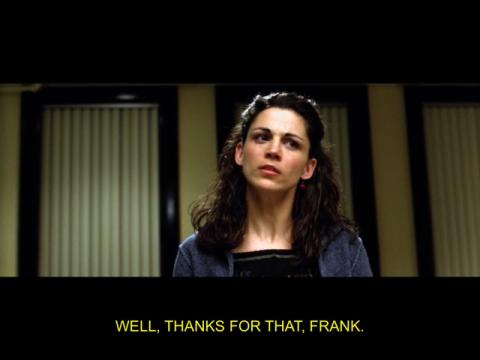“If your kundalini (spinal energy) awakens, you can go to America without a plane.”
~ Maharaji (Neem Karoli Baba).
quoted in Miracle Of Love
“If your kundalini (spinal energy) awakens, you can go to America without a plane.”
~ Maharaji (Neem Karoli Baba).
quoted in Miracle Of Love
This temple and whatever is seen by the human eye are illusion ... Delusion makes everything look real.
~ Maharaji (Neem Karoli Baba)
What you meet in another being is the projection of your own level of evolution.
~ Ram Dass
Attachment is what keeps you stuck in your limited reality.
~ Ram Dass
If you don’t appreciate me, that’s YOUR problem.
If I need your love or approval, that’s MY problem. Then my needs are giving you power over me.
~ Ram Dass
“Thanks for that, Frank.” One of many funny moments in the movie, You Kill Me.

This is a painting of a roadhouse in Wasilla, Alaska, circa 1957. It reminds me of living in Talkeetna. I found it on the “Last Frontier Magazine” Twitter page.

I watched Cloud Atlas over the last few nights. It’s a long but good movie, with six sub-stories that occur over a span of hundreds of years, where you get to see the ripple of good deeds over time. (Or at least that’s one interpretation of the movie.)

This book cover (nothing holy about it) has an interesting use of fonts and colors. I think I would have gone for a wee bit of transparency on the white font, and lined up the blue with the white, but it’s interesting, and essentially fits two subtitles on the cover.

May 19, 2015: Farming at 10:30pm. Photo from the Palmer, Alaska News Facebook page.

As I mentioned yesterday, I had an MRI recently, and the doctors noted that there is a lack of blood flow to three “deep white matter” locations. I think the three white spots in the middle/top of this MRI image are what they’re referring to, but I don’t know for sure yet. What I have learned is that the “gray matter” is on the outside of the brain, and the white matter is on the inside.

I have no idea how it works, but every once in a while you’ll have dreams that come true. For example, a few years ago one of my nieces got married, and even though I didn’t go to the wedding, two nights before the wedding I had a dream of a photo that was taken, and what I saw in the dream was exactly the same as the photo, even though I have never been to the place where they were married or seen photos of the place.
(Actually there was a difference: On the far side of each row of people I saw some relatives who passed away many years ago. They were also dressed in suits and dresses.)
Then a few weeks ago I had a dream that Dr. Ruth passed away, so when I saw that she actually passed away on July 12, 2024, I asked my wife, “Didn’t you tell me that Dr. Ruth died a few weeks ago?” She said no, she didn’t say anything like that, and then I remembered that that happened in a dream.
This doesn’t happen very often, but I used to make a note of such things because I thought it was fascinating. These are just two that I can remember off the top of my head.
“Most people treat the present moment as if it were an obstacle that they need to overcome. Since the present moment is life itself, it is an insane way to live.”
~ Eckhart Tolle
Without any introduction or discussion, here’s a little Scala script I just wrote to read in a text file that contains stocks symbols, with one symbol per line, along with some blank lines; then convert those symbols to comma-separated output (CSV format) that I print to STDOUT:
I just had this problem in Scala where I wanted to concatenate two corresponding multiline strings into one final multiline string, such that the elements from the first string were always at the beginning of each line, and the lines from the second string were always second. (When I say corresponding, I mean that the two strings are of equal length.)
That is, given two Scala multiline strings like these:
If you want to get a value out of a Scala Option type, there are a few ways to do it. In this article I’ll start by showing those approaches, and then discuss the approach of using the fold method on an Option (which I’ve seen discussed recently on Twitter).
As a first look at getting values out of an Option, a common way to extract the value out of a Scala Option is with a match expression:
I’ve been slowly working on a series of new Scala programming books, and today I’m proud to announce the first of these:
Starting today you can buy the PDF version of Learn Scala 3 The Fast Way! for just ten dollars — $10 (USD) — at this Gumroad.com URL.
Sister 1: “What about that cute guy I met? Condom Man.”
Sister 2: “Yes, that’s how he likes to be known.”
Sister 3: “Condom Man? Sounds like a superhero.”
~ from the movie, Must Love Dogs
Two sisters talking in the movie, Must Love Dogs:
“So can I ask you a question?”
“No.”
“You never would have left Kevin, would you?”
“If he hadn’t ... left me? No, I don’t think so.”
“But you weren’t really happy.”
“Well, I figured that was the life I picked, so I had to make the most of it. I’m not even sure I deserve a new life now. Sometimes I think that was supposed to be my one chance and I blew it.”
“Where did we get the bad attitudes?”
“The nuns?”
“Yeah, that works. Let’s blame the nuns.”